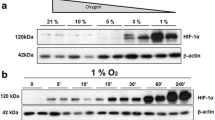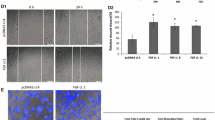Abstract
This study aimed to analyze the role of endothelial progenitor cell (EPC)-derived angiogenic factors and chemokines in the multistep process driving angiogenesis with a focus on the recently discovered macrophage migration inhibitory factor (MIF)/chemokine receptor axis. Primary murine and murine embryonic EPCs (eEPCs) were analyzed for the expression of angiogenic/chemokines and components of the MIF/CXC chemokine receptor axis, focusing on the influence of hypoxic versus normoxic stimulation. Hypoxia induced an upregulation of CXCR2 and CXCR4 but not CD74 on EPCs and triggered the secretion of CXCL12, CXCL1, MIF, and vascular endothelial growth factor (VEGF). These factors stimulated the transmigration activity and adhesive capacity of EPCs, with MIF and VEGF exhibiting the strongest effects under hypoxia. MIF-, VEGF-, CXCL12-, and CXCL1-stimulated EPCs enhanced tube formation, with MIF and VEGF exhibiting again the strongest effect following hypoxia. Tube formation following in vivo implantation utilizing angiogenic factor-loaded Matrigel plugs was only promoted by VEGF. Coloading of plugs with eEPCs led to enhanced tube formation only by CXCL12, whereas MIF was the only factor which induced differentiation towards an endothelial and smooth muscle cell (SMC) phenotype, indicating an angiogenic and differentiation capacity in vivo. Surprisingly, CXCL12, a chemoattractant for smooth muscle progenitor cells, inhibited SMC differentiation. We have identified a role for EPC-derived proangiogenic MIF, VEGF and MIF receptors in EPC recruitment following hypoxia, EPC differentiation and subsequent tube and vessel formation, whereas CXCL12, a mediator of early EPC recruitment, does not contribute to the remodeling process. By discerning the contributions of key angiogenic chemokines and EPCs, these findings offer valuable mechanistic insight into mouse models of angiogenesis and help to define the intricate interplay between EPC-derived angiogenic cargo factors, EPCs, and the angiogenic target tissue.






Similar content being viewed by others
Abbreviations
- MIF:
-
Macrophage migration inhibitory factor
- eEPC:
-
Embryonic endothelial progenitor cell
- EPC:
-
Endothelial progenitor cell
- SVEC:
-
Simian virus (SV) 40-immortalized murine endothelial cell
- CVD:
-
Cardiovascular disease
- CXC:
-
Chemokine or chemokine receptor of the CXC sub-family
References
Amin MA, Volpert OV, Woods JM, Kumar P, Harlow LA, Koch AE (2003) Migration inhibitory factor mediates angiogenesis via mitogen-activated protein kinase and phosphatidylinositol kinase. Circ Res 93:321–329. doi:10.1161/01.RES.0000087641.56024.DA
Anghelina M, Krishnan P, Moldovan L, Moldovan NI (2004) Monocytes and macrophages form branched cell columns in matrigel: implications for a role in neovascularization. Stem Cells Dev 13:665–676. doi:10.1089/scd.2004.13.665
Anghelina M, Krishnan P, Moldovan L, Moldovan NI (2006) Monocytes/macrophages cooperate with progenitor cells during neovascularization and tissue repair: conversion of cell columns into fibrovascular bundles. Am J Pathol 168:529–541
Asahara T, Murohara T, Sullivan A, Silver M, van der Zee R, Li T, Witzenbichler B, Schatteman G, Isner JM (1997) Isolation of putative progenitor endothelial cells for angiogenesis. Science 275:964–967. doi:10.1126/science.275.5302.964
Belo AV, Leles F, Barcelos LS, Ferreira MA, Bakhle YS, Teixeira MM, Andrade SP (2005) Murine chemokine CXCL2/KC is a surrogate marker for angiogenic activity in the inflammatory granulation tissue. Microcirculation 12:597–606. doi:10.1080/10739680500253535
Bernhagen J, Krohn R, Lue H, Gregory JL, Zernecke A, Koenen RR, Dewor M, Georgiev I, Schober A, Leng L, Kooistra T, Fingerle-Rowson G, Ghezzi P, Kleemann R, McColl SR, Bucala R, Hickey MJ, Weber C (2007) MIF is a noncognate ligand of CXC chemokine receptors in inflammatory and atherogenic cell recruitment. Nat Med 13:587–596. doi:10.1038/nm1567
Bernhagen J, Mitchell RA, Calandra T, Voelter W, Cerami A, Bucala R (1994) Purification, bioactivity, and secondary structure analysis of mouse and human macrophage migration Inhibitory factor (MIF). Biochemistry 33:14144–14155
Carmeliet P (2003) Angiogenesis in health and disease. Nat Med 9:653–660. doi:10.1038/nm0603-653
Carmeliet P (2000) VEGF gene therapy: stimulating angiogenesis or angioma-genesis? Nat Med 6:1102–1103. doi:10.1038/80430
Ceradini DJ, Kulkarni AR, Callaghan MJ, Tepper OM, Bastidas N, Kleinman ME, Capla JM, Galiano RD, Levine JP, Gurtner GC (2004) Progenitor cell trafficking is regulated by hypoxic gradients through HIF-1 induction of SDF-1. Nat Med 10:858–864. doi:10.1038/nm1075
Chesney J, Metz C, Bacher M, Peng T, Meinhardt A, Bucala R (1999) An essential role for macrophage migration inhibitory factor (MIF) in angiogenesis and the growth of a murine lymphoma. Mol Med 5:181–191 (PMCID: PMC2230298)
Deregibus MC, Cantaluppi V, Calogero R, Lo Iacono M, Tetta C, Biancone L, Bruno S, Bussolati B, Camussi G (2007) Endothelial progenitor cell derived microvesicles activate an angiogenic program in endothelial cells by a horizontal transfer of mRNA. Blood 110:2440–2448. doi:10.1182/blood-2007-03-078709
Dewor M, Steffens G, Krohn R, Weber C, Baron J, Bernhagen J (2007) Macrophage migration inhibitory factor (MIF) promotes fibroblast migration in scratch-wounded monolayers in vitro. FEBS Lett 581:4734–4742. doi:10.1016/j.febslet.2007.08.071 pii: S0014-5793(07)00958-1
Ferrara N, Davis-Smyth T (1997) The biology of vascular endothelial growth factor. Endocr Rev 18:4–25. doi:10.1210/er.18.1.4
Ferrara N, Gerber HP, LeCouter J (2003) The biology of VEGF and its receptors. Nat Med 9:669–676. doi:10.1038/nm0603-669
Flieger O, Engling A, Bucala R, Lue H, Nickel W, Bernhagen J (2003) Regulated secretion of macrophage migration inhibitory factor is mediated by a non-classical pathway involving an ABC transporter. FEBS Lett 551:78–86 pii:S0014579303009001
Folkman J (1998) Angiogenic therapy of the human heart. Circulation 97:628–629. doi:10.1161/01.CIR.97.7.628
Gerber HP, Hillan KJ, Ryan AM, Kowalski J, Keller GA, Rangell L, Wright BD, Radtke F, Aguet M, Ferrara N (1999) VEGF is required for growth and survival in neonatal mice. Development 126:1149–1159
Grieb G, Piatkowski A, Simons D, Hormann N, Dewor M, Steffens G, Bernhagen J, Pallua N (2012) Macrophage migration inhibitory factor is a potential inducer of endothelial progenitor cell mobilization after flap operation. Surgery 151:268-277.e261. doi:10.1016/j.surg.2010.10.008
Hatzopoulos AK, Folkman J, Vasile E, Eiselen GK, Rosenberg RD (1998) Isolation and characterization of endothelial progenitor cells from mouse embryos. Development 125:1457–1468
Hinkel R, El-Aouni C, Olson T, Horstkotte J, Mayer S, Muller S, Willhauck M, Spitzweg C, Gildehaus FJ, Munzing W, Hannappel E, Bock-Marquette I, DiMaio JM, Hatzopoulos AK, Boekstegers P, Kupatt C (2008) Thymosin beta4 is an essential paracrine factor of embryonic endothelial progenitor cell-mediated cardioprotection. Circulation 117:2232–2240. doi:10.1161/CIRCULATIONAHA.107.758904
Hur J, Yoon CH, Kim HS, Choi JH, Kang HJ, Hwang KK, Oh BH, Lee MM, Park YB (2004) Characterization of two types of endothelial progenitor cells and their different contributions to neovasculogenesis. Arterioscler Thromb Vasc Biol 24:288–293. doi:10.1161/01.ATV.0000114236.77009.06
Ingram DA, Mead LE, Tanaka H, Meade V, Fenoglio A, Mortell K, Pollok K, Ferkowicz MJ, Gilley D, Yoder MC (2004) Identification of a novel hierarchy of endothelial progenitor cells using human peripheral and umbilical cord blood. Blood 104:2752–2760. doi:10.1182/blood-2004-04-1396
Keane MP, Belperio JA, Xue YY, Burdick MD, Strieter RM (2004) Depletion of CXCR2 inhibits tumor growth and angiogenesis in a murine model of lung cancer. J Immunol 172:2853–2860
Klug MG, Soonpaa MH, Koh GY, Field LJ (1996) Genetically selected cardiomyocytes from differentiating embryonic stem cells form stable intracardiac grafts. J Clin Investig 98:216–224. doi:10.1172/JCI118769
Kortesidis A, Zannettino A, Isenmann S, Shi S, Lapidot T, Gronthos S (2005) Stromal-derived factor-1 promotes the growth, survival, and development of human bone marrow stromal stem cells. Blood 105:3793–3801. doi:10.1182/blood-2004-11-4349
Kucia M, Reca R, Miekus K, Wanzeck J, Wojakowski W, Janowska-Wieczorek A, Ratajczak J, Ratajczak MZ (2005) Trafficking of normal stem cells and metastasis of cancer stem cells involve similar mechanisms: pivotal role of the SDF-1-CXCR4 axis. Stem Cells 23:879–894. doi:10.1634/stemcells.2004-0342
Kupatt C, Bock-Marquette I, Boekstegers P (2008) Embryonic endothelial progenitor cell-mediated cardioprotection requires Thymosin beta4. Trends Cardiovasc Med 18:205–210. doi:10.1016/j.tcm.2008.10.002
Kupatt C, Horstkotte J, Vlastos GA, Pfosser A, Lebherz C, Semisch M, Thalgott M, Buttner K, Browarzyk C, Mages J, Hoffmann R, Deten A, Lamparter M, Muller F, Beck H, Buning H, Boekstegers P, Hatzopoulos AK (2005) Embryonic endothelial progenitor cells expressing a broad range of proangiogenic and remodeling factors enhance vascularization and tissue recovery in acute and chronic ischemia. FASEB J 19:1576–1578. doi:10.1096/fj.04-3282fje
Lassaletta AD, Chu LM, Sellke FW (2011) Therapeutic neovascularization for coronary disease: current state and future prospects. Basic Res Cardiol 106:897–909. doi:10.1007/s00395-011-0200-1
Liehn EA, Postea O, Curaj A, Marx N (2011) Repair after myocardial infarction, between fantasy and reality: the role of chemokines. J Am Coll Cardiol 58:2357–2362. http://dx.doi.org/10.1016/j.jacc.2011.08.034
Liehn EA, Schober A, Weber C (2004) Blockade of keratinocyte-derived chemokine inhibits endothelial recovery and enhances plaque formation after arterial injury in ApoE-deficient mice. Arterioscler Thromb Vasc Biol 24:1891–1896. doi:10.1161/01.ATV.0000143135.71440.75
Liehn EA, Tuchscheerer N, Kanzler I, Drechsler M, Fraemohs L, Schuh A, Koenen RR, Zander S, Soehnlein O, Hristov M, Grigorescu G, Urs AO, Leabu M, Bucur I, Merx MW, Zernecke A, Ehling J, Gremse F, Lammers T, Kiessling F, Bernhagen J, Schober A, Weber C (2011) Double-edged role of the CXCL12/CXCR4 axis in experimental myocardial infarction. J Am Coll Cardiol 58:2415-2423. http://dx.doi.org/10.1016/j.jacc.2011.08.033
Lue H, Kleemann R, Calandra T, Roger T, Bernhagen J (2002) Macrophage migration inhibitory factor (MIF): mechanisms of action and role in disease. Microbes Infect 4:449–460 pii:S1286457902015605
Ma Q, Jones D, Borghesani PR, Segal RA, Nagasawa T, Kishimoto T, Bronson RT, Springer TA (1998) Impaired B-lymphopoiesis, myelopoiesis, and derailed cerebellar neuron migration in CXCR4- and SDF-1-deficient mice. Proc Natl Acad Sci USA 95:9448–9453 (PMCID: PMC21358Immunology)
Mammoto A, Connor KM, Mammoto T, Yung CW, Huh D, Aderman CM, Mostoslavsky G, Smith LE, Ingber DE (2009) A mechanosensitive transcriptional mechanism that controls angiogenesis. Nature 457:1103–1108. doi:10.1038/nature07765
Poss J, Werner C, Lorenz D, Gensch C, Bohm M, Laufs U (2010) The renin inhibitor aliskiren upregulates pro-angiogenic cells and reduces atherogenesis in mice. Basic Res Cardiol 105:725–735. doi:10.1007/s00395-010-0120-5
Rehman J, Li J, Orschell CM, March KL (2003) Peripheral blood “endothelial progenitor cells” are derived from monocyte/macrophages and secrete angiogenic growth factors. Circulation 107:1164–1169. doi:10.1161/01.CIR.0000058702.69484.A0
Schober A, Bernhagen J, Thiele M, Zeiffer U, Knarren S, Roller M, Bucala R, Weber C (2004) Stabilization of atherosclerotic plaques by blockade of macrophage migration inhibitory factor after vascular injury in apolipoprotein E-deficient mice. Circulation 109:380–385. doi:10.1161/01.CIR.0000109201.72441.09
Schober A, Knarren S, Lietz M, Lin EA, Weber C (2003) Crucial role of stromal cell-derived factor-1alpha in neointima formation after vascular injury in apolipoprotein E-deficient mice. Circulation 108:2491–2497. doi:10.1161/01.CIR.0000099508.76665.9A
Schuh A, Liehn EA, Sasse A, Hristov M, Sobota R, Kelm M, Merx MW, Weber C (2008) Transplantation of endothelial progenitor cells improves neovascularization and left ventricular function after myocardial infarction in a rat model. Basic Res Cardiol 103:69–77. doi:10.1007/s00395-007-0685-9
Simons D, Grieb G, Hristov M, Pallua N, Weber C, Bernhagen J, Steffens G (2011) Hypoxia-induced endothelial secretion of macrophage migration inhibitory factor and role in endothelial progenitor cell recruitment. J Cell Mol Med 15:668–678. doi:10.1111/j.1582-4934-2010-01-041.x
Simons M, Bonow RO, Chronos NA, Cohen DJ, Giordano FJ, Hammond HK, Laham RJ, Li W, Pike M, Sellke FW, Stegmann TJ, Udelson JE, Rosengart TK (2000) Clinical trials in coronary angiogenesis: issues, problems, consensus: an expert panel summary. Circulation 102:E73–E86. doi:10.1161/01.CIR.102.11.e73
Vajkoczy P, Blum S, Lamparter M, Mailhammer R, Erber R, Engelhardt B, Vestweber D, Hatzopoulos AK (2003) Multistep nature of microvascular recruitment of ex vivo-expanded embryonic endothelial progenitor cells during tumor angiogenesis. J Exp Med 197:1755–1765. doi:10.1084/jem.20021659
Walcher D, Vasic D, Heinz P, Bach H, Durst R, Hausauer A, Hombach V, Marx N (2010) LXR activation inhibits chemokine-induced CD4-positive lymphocyte migration. Basic Res Cardiol 105:487–494. doi:10.1007/s00395-010-0092-5
Walenta KL, Bettink S, Bohm M, Friedrich EB (2011) Differential chemokine receptor expression regulates functional specialization of endothelial progenitor cell subpopulations. Basic Res Cardiol 106:299–305. doi:10.1007/s00395-010-0142-z
Zernecke A, Bernhagen J, Weber C (2008) Macrophage migration inhibitory factor in cardiovascular disease. Circulation 117:1594–1602. doi:10.1161/CIRCULATIONAHA.107.729125
Acknowledgments
We thank Nives Hörmann and Meike Jung for assistance with the hypoxia experiments and Kiril Bidzhekov and Christian Kupatt for providing the eEPC cell clone. This study was supported by IZKF Aachen (K1-2, K1-4) of the Faculty of Medicine, RWTH Aachen University to E.L. and J.B., by the Deutsche Forschungsgemeinschaft (DFG) grants BE1977/4-2/FOR 809 and GRK1508/1-P13 to J.B.), and the NIH (R.B.).
Conflict of interest
None.
Author information
Authors and Affiliations
Corresponding authors
Additional information
I. Kanzler and N. Tuchscheerer contributed equally to this work.
Electronic supplementary material
Below is the link to the electronic supplementary material.
Rights and permissions
About this article
Cite this article
Kanzler, I., Tuchscheerer, N., Steffens, G. et al. Differential roles of angiogenic chemokines in endothelial progenitor cell-induced angiogenesis. Basic Res Cardiol 108, 310 (2013). https://doi.org/10.1007/s00395-012-0310-4
Received:
Revised:
Accepted:
Published:
DOI: https://doi.org/10.1007/s00395-012-0310-4




